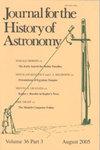Determining the right time, or the establishment of a culture of astronomical precision at Neuchâtel Observatory in the mid-19th century
IF 0.3
3区 哲学
Q3 HISTORY & PHILOSOPHY OF SCIENCE
引用次数: 1
Abstract
In the mid-19th century, the need for an accurate time becomes ever more important for many economic and industrial sectors, as well as for maritime and railway transport. States took a keen interest in these developments, which resulted in the founding of an increasing number of state observatories. While this well-known phenomenon has attracted the attention of numerous historical researches, the actual setting up of an observatory has more rarely been studied. Based on the well-documented case of the Observatoire cantonal de Neuchâtel, we will look at the setting up of the establishment through its scientific instruments and work procedure. Founded in 1858, the Observatory was primarily intended to fulfill the needs of the watchmaking industry while contributing to the progressive standardization of Swiss time. Adolphe Hirsch, the Observatory’s first director, spent 3 years setting up, installing, and calibrating an operating chain dedicated to the time service. The astronomer’s correspondence shows his expectations and the manufacturers’ technical capabilities. We can thus reconstruct the steps in the design of the scientific instruments—which operated as a network. The outcome being a high-performance operating chain for the time determination. During the commissioning process, Adolphe Hirsch chose an emerging technology—the printing chronograph. In fact, the Observatory was entirely configured around this new method, placing this institution among the first in the field. This new observation technique modifies the episteme of time determination and the role of the human factor within the process.确定正确的时间,或在19世纪中期在Neuchâtel天文台建立天文精度文化
在19世纪中期,对于许多经济和工业部门以及海运和铁路运输来说,对准确时间的需求变得越来越重要。各国对这些事态发展非常感兴趣,因此建立了越来越多的国家天文台。虽然这一众所周知的现象引起了许多历史研究的注意,但实际建立天文台的研究却很少。根据有充分记录的国家天文台de neuch tel的案例,我们将通过其科学仪器和工作程序来研究该机构的建立。天文台成立于1858年,主要是为了满足制表行业的需求,同时为瑞士时间的逐步标准化做出贡献。天文台首任台长阿道夫·赫希(Adolphe Hirsch)花了3年时间建立、安装和校准一条专门用于报时服务的操作链。天文学家的通信表明了他的期望和制造商的技术能力。这样,我们就可以重建科学仪器的设计步骤——它们像一个网络一样运行。结果是一个高性能的操作链的时间确定。在调试过程中,Adolphe Hirsch选择了一项新兴技术——印刷计时码表。事实上,天文台完全围绕这种新方法进行了配置,使该机构成为该领域的首批机构之一。这种新的观测技术改变了时间确定的认识和过程中人为因素的作用。
本文章由计算机程序翻译,如有差异,请以英文原文为准。
求助全文
约1分钟内获得全文
求助全文
来源期刊

Journal for the History of Astronomy
地学天文-科学史与科学哲学
CiteScore
0.50
自引率
25.00%
发文量
44
审稿时长
>12 weeks
期刊介绍:
Science History Publications Ltd is an academic publishing company established in 1971 and based in Cambridge, England. We specialize in journals in history of science and in particular history of astronomy.
 求助内容:
求助内容: 应助结果提醒方式:
应助结果提醒方式:


